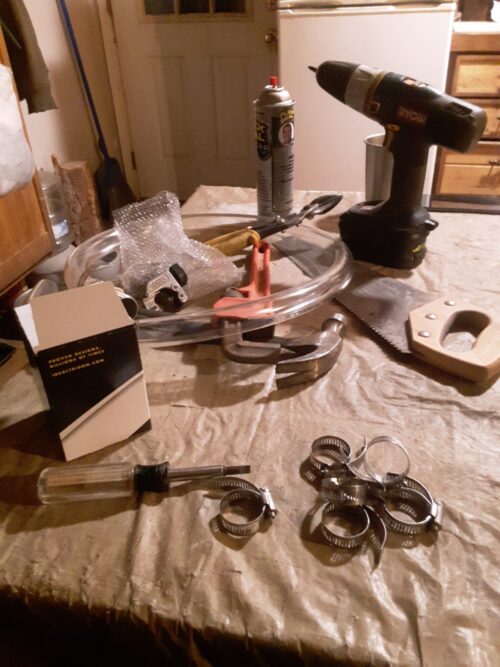
Of course, it’s not easy to establish and maintain long-term water sustainability. K has a rain-water catchment system that leads to an underground cistern. A pump transfers water to a tank in the attic, which then gravity-feeds into the faucets and shower head. (Note: If you want to implement a similar system, check local regulations first.)
Earlier this month, that tank froze and burst, sending 85 gallons of water cascading down onto the dining table. What a mess.
We’ve managed to clean up the water, but before we could have running water again, we needed to get another tank and fittings. Sounds simple enough, right? Not so. The ideal tank would be thick enough to hold that much water weight for a long period of time (remember, 1 gallon of water weighs 8 lbs) but thin enough to flex a bit if the tank does freeze again. It would need an inlet, an outlet, and an overflow the same size as the existing pipes. The tank’s dimensions would need to be small enough to fit through the attic door and fit where the previous tank was, but large enough to ideally hold a week’s worth of water.
We found a tank that we hope will work, but shipping it meant it would take over a week to arrive. This meant we would go two weeks without running water. Not the end of the world because we could just fill a 5-gallon bucket with water from the cistern and use that, but still really tiresome.
How do we manage without running water? With difficulty. We have a 1-gallon jug in the bathroom for washing hands and brushing teeth, and a 5-gallon bucket in the kitchen for cooking, washing dishes, filling up the dogs’ water bowl, etc. For flushing, we reuse bath water. But how can we draw a bath without running water? If it was summer, drawing a cold bath would just involve hauling several 5-gallon buckets of water to the tub. But this is winter, and I want a hot bath. So, in addition to hauling in cold water, we need to heat up large pots of water on the stove and add these in. This, of course, is how people used to draw baths before hot running water was easily available in the U.S. Four hours later, we had a hot bath drawn. And what about laundry? K has a portable washing machine which can be hooked up to the sink. With no running water, we need to fill it with a couple of 5-gallon buckets of water. Not impossible, but certainly difficult and I’m really looking forward to having running water again!
When the tank and fittings finally arrived, we discovered the descriptions didn’t exactly match what we got. This is not an uncommon problem. No matter, though this delayed the operation, I just bought another set of fittings since I was in town, and figured we could make it work. Within the day, we had the fittings on the tank and thought we’d have running water in no time. But then we found out the tubing we needed to connect the fittings to the existing pipe was labeled incorrectly. K also found out the person who put in the plumbing had reduced the pipe size on the way up to the attic. This turned out to work great for the tubing, but our fittings were wrong. This involved another trip into town to get the right fittings, a 90-minute commitment.
The next day, we opened the box of hose clamps which would secure the tubing to the fittings, and found their smallest setting wasn’t tight enough for the mis-labeled tubing. This being on a Sunday, the hardware store was closed.
Yet another day with no running water.
The next day, we picked up smaller hose clamps. All set, I thought. Then K mentioned the large number of fittings increased chances of a leak, so we needed to put several more layers of sealant onto the fittings before moving the tank to the attic.
Now we’re on our third week without running water, but hopefully we can set up the new tank this weekend, if nothing else surprises us. Will it work? Stay tuned. In the meantime, our rescued dining table continues to be covered with the tools and parts we need for this replacement project. To make this more interesting, both K and I were sick/hurt for some of this time.
Use our experience to remember to check all sizes and parts before starting a project.
